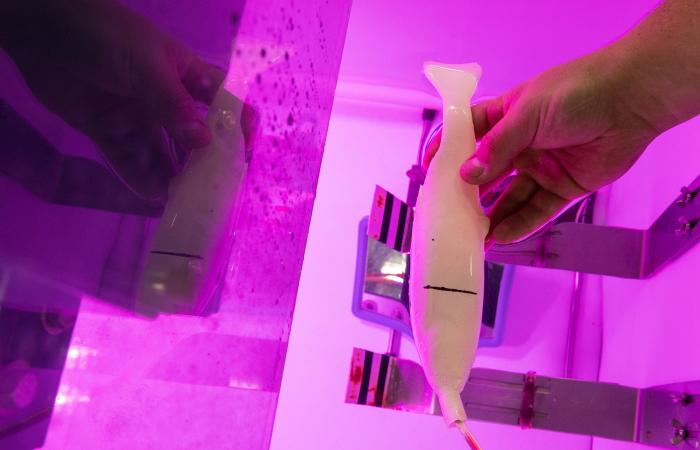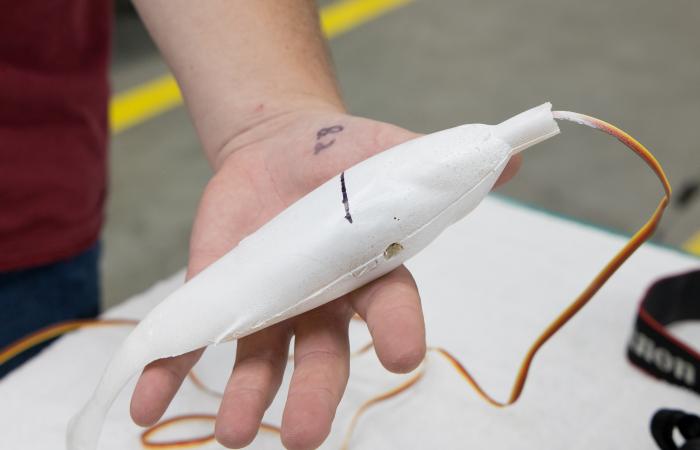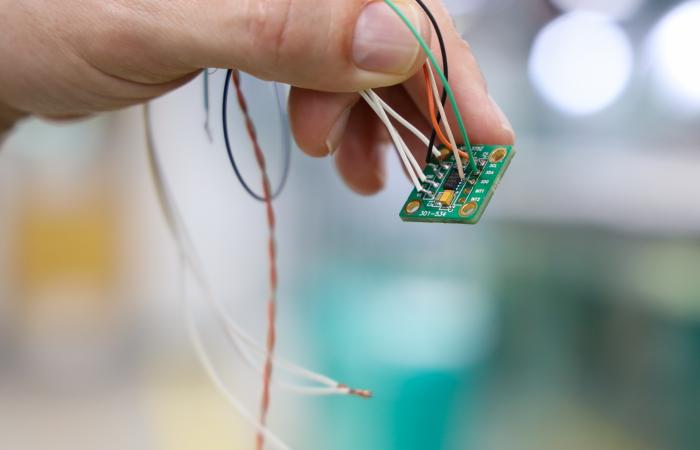-

ORNL scientists are combining their expertise in environmental science, physics, sensors and additive manufacturing to create model fish for use in testing of hydropower turbine designs. The project supports healthy ecosystems and hydropower-the nation's largest renewable energy resource. Photo credit: Oak Ridge National Laboratory, U.S. Dept. of Energy.
-

ORNL scientists are combining their expertise in environmental science, physics, sensors and additive manufacturing to create model fish for use in testing of hydropower turbine designs. The project supports healthy ecosystems and hydropower-the nation's largest renewable energy resource. Photo credit: Oak Ridge National Laboratory, U.S. Dept. of Energy.
-

ORNL scientists are combining their expertise in environmental science, physics, sensors and additive manufacturing to create model fish for use in testing of hydropower turbine designs. The project supports healthy ecosystems and hydropower-the nation's largest renewable energy resource. Photo credit: Oak Ridge National Laboratory, U.S. Dept. of Energy.
-

ORNL scientists are combining their expertise in environmental science, physics, sensors and additive manufacturing to create model fish for use in testing of hydropower turbine designs. The project supports healthy ecosystems and hydropower-the nation's largest renewable energy resource. Photo credit: Oak Ridge National Laboratory, U.S. Dept. of Energy.
-

ORNL scientists are combining their expertise in environmental science, physics, sensors and additive manufacturing to create model fish for use in testing of hydropower turbine designs. The project supports healthy ecosystems and hydropower-the nation's largest renewable energy resource. Photo credit: Oak Ridge National Laboratory, U.S. Dept. of Energy.
-

ORNL scientists are combining their expertise in environmental science, physics, sensors and additive manufacturing to create model fish for use in testing of hydropower turbine designs. The project supports healthy ecosystems and hydropower-the nation's largest renewable energy resource. Photo credit: Oak Ridge National Laboratory, U.S. Dept. of Energy.
Hydropower developers must consider many factors when it comes time to license a new project or renew an existing one: How can environmental impacts be mitigated, including to fish populations? Researchers at the Department of Energy's Oak Ridge National Laboratory have landed a unique solution: using 3D printing and sensors to create fake fish for turbine testing.
When fish pass through hydropower dams, they encounter obstacles that can cause injuries-pressure changes, turbulence, and spinning blades on turbines. As part of its environmental assessment work for hydropower projects, ORNL developed a system to analyze the impact of turbine designs on high-value species.
"We want to understand the forces different fish species encounter and how those forces may result in injury or mortality," said Ryan Saylor, a Bredesen Center for Interdisciplinary Research and Graduate Education student working in ORNL's Environmental Sciences Division. "There may be tweaks that turbine designers and manufacturers could make that would conserve fish species while at the same time minimizing the impact on energy production."
The work is important. Hydropower is the largest source of renewable energy and utility-scale energy storage in the country, accounting for 6% of total electricity generation. ORNL has a long history of supporting hydropower, including improvements to the licensing and regulatory process.
There are many factors to take into account when testing hydropower impacts on fish: how fast the blades are moving, the thickness and angle of the blades, how big each fish is and where its center of mass sits.
"What we realized is that it's essentially a physics problem," added Mark Bevelhimer, who launched the project and has recently retired from ORNL.
The scientists decided to create a model fish-in technical terms, an anthropomorphic test device-to help them understand the forces of the turbine blades and generate multiple data points for analysis.
They came up with the idea of using ballistic gel for the fish body. The gel, originally developed for military purposes, can be controlled for different densities to mimic muscle tissue.
To create molds for various fish species, the researchers turned to the 3D printing capabilities at the Manufacturing Demonstration Facility, a DOE designated user facility at ORNL. The researchers brought fish to the MDF to be laser-scanned, and the resulting contours were fed into a computer-aided design program that in turn guided a 3D printer to create molds of each fish to be tested.
Brian Post, who led the MDF effort, noted that 3D printing the molds is a fast, low-cost solution that allows for the creation of a large variety of fish models in a short period of time. "Each species has a different morphology, so making molds allows us to capture those differences. We can make a one-of-a-kind fish pretty easily. If you were to conventionally produce the molds, it would take longer to subtract the shape out of a block of material," Post explained.
The environmental scientists mixed the ballistic gel with cinnamon oil (an inexpensive antimicrobial agent) and then filled the molds and let the gel set. The team tested the "squishiness" of subsequent fake fish to get as close as possible to reality. The scientists then coated the fish in a plastic-like paint to give them more rigidity and to mimic skin and scales.
Sensors embedded in the models measure acceleration and G-forces in the turbine simulator in three dimensions. Strain gauges are also used to measure how the fish stretch or contract internally and externally as a result of the simulated strikes.
The scientists continue to improve the model, including increasing the response rate, which in turn should result in higher resolution of data, as well as advances in data extraction and analysis. So far they have created and tested models of four fish species: rainbow trout, bluegill, shad and bass.
The project was funded by ORNL's Laboratory Directed Research and Development program.
"Mimicking biology is difficult," Saylor noted. "We've worked to get as close as we can to a good representation without the use of specialized equipment that could increase costs."
The fact that there's little standardization of hydropower projects presents an opportunity for more work, the scientists noted. Hydropower dams have largely been constructed according to each site's geography and the power needs of the customer, so every project is different.
"We want to produce hydropower in a way that's not damaging to the fish passing through," Bevelhimer said. "There is a lot of pressure on power dam owners and operators to reduce their environmental impact. There are lots of challenges, and giving fish safer passage is one of them."






